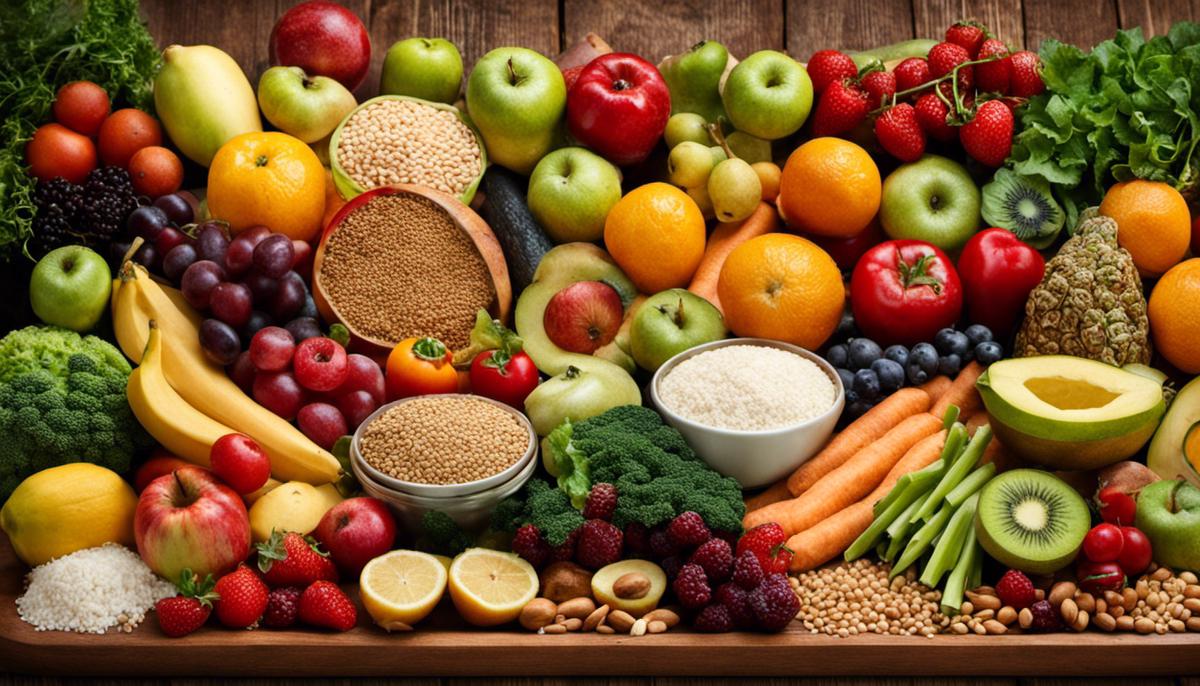In pursuit of better health, weight management, and overall well-being, understanding and prioritizing balanced, nutritious meals is essential. This realization has significance at all life stages—from children to adolescents, adults, expectant mothers, and the elderly—since each phase comes with unique dietary requirements. A failure to meet these nutritional needs can result in a myriad of health problems. This article attempts to dispel the confusion surrounding this subject by providing practical and adaptable tips for planning nutritious meals. It further explores the correlation between balanced meals and weight management, inclusive of advice on portion control and selecting nutrient-rich foods. Added to this, the article proposes creative strategies to get children enthusiastic about preparing and eating healthy meals.
Understanding Nutritional Needs
Balancing the Nutritional Needs of Your Beloved Family
As you gather your family around the dinner table, the aroma of a homecooked meal filling the air, love and care are inherently present in every dish prepared. Yet, meeting the nutritional needs of each family member can seem like a daunting task. With various age groups and nutritional requirements in one household, you might be wondering, “how can I adequately meet everyone’s diverse needs?” Fear not! It’s easier than you think.
An essential part of family health is nutrition, and having a balanced diet is critical. Open the gateway to a healthier family life with an understanding of the nutrients essential for different age groups and some tips to incorporate them effortlessly into your family’s diet.
Starting with our youngest members, children are in a constant state of growth and development, requiring specific nutrients to support this process. Essential nutrients for them are proteins, carbohydrates, fruits, and vegetables. Fret not if your child is a picky eater! Be creative! Disguise peas and carrots in a mouthwatering potpie or blend fruits into a refreshing smoothie. Experiment with various cooking methods until you find the right one to reel them in.
On to the teenagers, these growing adults need almost everything! Facing rapid growth and development, they require a balance of grains, lean proteins, fruits, vegetables, and dairy, or dairy substitutes for your vegan teens. It’s also the time when they become more aware and conscious about their eating habits. Make sure to keep dialogue open, reinforcing the importance of nutrition over appearance. Establish a healthy food relationship early on.
Interestingly, adults often have varying nutritional needs depending on health conditions and lifestyle but generally require a balance of all major food groups. Additionally, they might need specific dietary adjustments like lower sodium for those managing blood pressure or more calcium for the bone health of menopausal females.
For senior members, their digestive system slows down, requiring a more fiber-rich diet. While you ensure a good intake of lean protein, dairy, fruits, and vegetables, take care to lessen the intake of sugary foods and unhealthy fats.
Now, how can we cater to these vast needs without tiring out from preparing a separate meal for everyone? A great tip is to follow a mixed-dish approach. A family favorite stew or casserole packs in proteins, carbs, and veggies all in one dish. Serving sizes can be adjusted based on individual requirements.
Embrace the versatility of smoothies and salads, too! They’re an excellent source of vitamins and fiber and can enjoy variation based on individual preferences. Ensure that you provide options for whole grains, dairy or dairy substitute items at each meal. That means oatmeal for breakfast, a salad at lunch with beans and cheese, and a wholesome dinner with brown rice or pasta.
Suppose you have members with particular dietary restrictions. In that case, you can substitute ingredients to suit their needs, like using gluten-free pasta or almond milk. There are numerous healthy alternatives available in today’s markets. It’s just a matter of discovering what fits for your family.
Integrating good nutrition into family lifestyle needn’t be a task of Hercules. It is a path that can be walked together, back to basics, with a dash of creativity, and heaps of love. Encourage each other on this journey, and soon enough, everyone’s nutritional needs will be met with ease. With every delicious, balanced meal you prepare, the vibrant health of your family will be the scrumptious result, and that’s the best reward any family can ask for. Enjoy the journey to healthier meals; your family is worth every effort!

Planning Balanced and Nutritious Meals
Creating a nutritionally sound and balanced meal requires careful considerations to ensure every family member’s dietary needs are met. With a consistent, patient, and enjoyable approach, meal planning can evolve into an art that improves the overall health and wellbeing of our loved ones. Below are some effective strategies for planning nutritious and balanced meals for your family.
Plan A Weekly Menu
A significant step primarily involves creating a weekly menu. This approach leads to diversification in meals, making sure everyone gets a variety of nutrients. Don’t shy away from involving your family in the menu planning process. When children participate, they are more likely to enjoy the meals they helped plan.
Incorporate Seasonal and Local Produce
With every new season comes a fresh batch of fruits and vegetables, loaded with an abundance of nutrients. Try incorporating them into your meals. Not only will your dishes be more vibrant and flavorful, but you’ll also be supporting local farmers.
Prepare Meals Together
Preparing meals together can be a fun and engaging way to learn about nutrition. It also provides an opportunity to show the kids how tasty foods can be crafted from simple, healthy ingredients.
Unique Presentation Matters
A visually appealing meal is more likely to get eaten. Use creativity to make meals visually interesting, especially for the little ones. Use cookie cutters for fruits and pizza or arrange vegetables in the shape of a smiley face.
Motivate with Healthy Snacks
Tackle the mid-meal munchies with healthy snacks. Replace chips with air-popped popcorn or celery sticks with peanut butter. Prepare mason jars filled with Greek yogurt and fruits to appease sweet tooths.
Rotate Protein Sources
Proteins are vital for growth and development, especially for children. Rotate between different sources—like poultry, beef, fish, and plant-based proteins—to ensure variety and comprehensive nutrition.
Include Whole Grains
Whole grains are vital for supplying fiber and keeping your family energized throughout the day. Incorporate foods like brown rice, grits, and whole wheat pasta into your meals.
Stay Hydrated
Nutrition isn’t only about what you eat, but what you drink as well. Change up hydration options with infused water, homemade fruit juices, or tea to make water intake more interesting.
Educate Through Meal Prep
Each meal presents a learning opportunity. Discuss with your family why certain ingredients are chosen over others and the nutritional benefits they offer.
Strive for Sustainability
Lastly, remember that creating a healthy eating environment doesn’t happen overnight. It requires time, patience, and consistency. Keep emphasizing the importance of balanced and healthful eating habits and celebrate every small victory. Strive to maintain sustainability and approach meal planning as a continuous journey towards better nutrition. Nurture this practice with joy and perseverance, enhancing your family’s health and unity, one meal at a time.

Healthy Weight Management
With an understanding of the importance of nutrition in family health and the specific dietary needs of varying age groups, one can delve deeper into the process of weight management in everyday meal planning. This is where things can become more interesting and engaging, all while promoting healthier lifestyles.
Planning a weekly menu is one of the most effective strategies to manage weight and nutrition. This approach not only allows for conscious intake of varied essential nutrients but also helps in reducing unnecessary, impulsive eating. Plus, it can easily become a family activity. Coupling it with a portion control guide can help monitor weight without compromising on flavor or food variety.
While planning your weekly menu, don’t forget to incorporate seasonal and local produce. These are often fresher and contain more nutrients than those that are shipped and stored. They’re often more flavorful too, helping reduce the need for extra seasonings or sugars.
Believe it or not, the simple act of preparing meals together has enormous benefits. It fosters healthy eating habits, promotes better weight management, and nurtures stronger family bonds. When family members are actively involved in meal prep, they’re more likely to appreciate a balanced diet.
When we talk about kids, it’s essential to realize that presentation matters. Making meals visually appealing can motivate even the pickiest eaters! Benefit from colorful fruits and vegetables, design creative lunchbox ideas, or use fun-shaped cutters for sandwiches, making the mealtime an exciting experience.
Just like meals, snacks should be a part of your strategy for weight management. Offer a daily dose of healthy snacks, such as nuts, berries, or low-fat yogurt. Rotate them often to maintain variety, and you’ll find that it’s easier to avoid processed goods with high sugar and sodium content.
Taking this concept of rotation, let’s apply it to one of the main components of any meal: proteins. One day, it could be poultry, another day, fish, then legumes, and so on. Diversifying protein sources not only keeps meals exciting but gives the body a range of essential amino acids, supporting weight management by building lean muscle tissue.
Including whole grains in meals is another invaluable tip. Packed with fiber, they enhance digestion, provide lasting energy, and aid in weight management by promoting feelings of fullness. Plus, they add a pleasant, rustic texture to meals that many families love.
Hydration is a key factor not to be ignored. While it doesn’t directly contribute calories, staying hydrated is crucial to weight management. Water can help curb overeating, stimulate metabolism, and cleanse the body.
Lastly, education plays a pivotal role. Meal prep is not just about cooking but teaching kids about nutritional values, kitchen safety, the importance of balanced meals, and the value of homemade food. This knowledge will help them make informed decisions as they grow older.
Striving for sustainability ties all these concepts together. Teach the family about food waste, the benefits of composting, kitchen gardening, recycling, and repurposing. A sustainable approach to meal planning isn’t just good for the family’s health; it’s beneficial for the whole planet.

Inspiring Kids to Eat Healthy
Craft Family-Friendly Food Experiences
As a family, mealtime isn’t just about nutrition, it’s a cherished moment – a time for creating memories. What’s more memorable than exploring new tastes and textures together? Indeed, the journey towards healthy eating can be a delightful shared experience and there’s no better way to cultivate this love for nutritious food than making it a part of your everyday family adventure.
- Go on a cultural food experience at home: A great way to introduce children to a variety of vegetables and lean proteins is to explore international cuisines. The vibrant colors, diverse flavors, and enticing smells can trigger their curiosity and make them eager to taste new healthy options. Try Mediterranean, Indian, or Asian recipes that embrace fresh, nutritious ingredients and watch your family enjoy the delightful culinary journey!
- Food art as a fun project: Involve your kids in creating food art using a mix of fruits, vegetables, and other nutritious foods. This playful approach could help them be more receptive to eating healthy foods. Let them create a rainbow with different colored fruits and vegetables, use whole wheat bread for a canvas, peanut butter for ‘glue’ and assorted nuts, seeds, or colorful veggies for decoration. It’s a wonder how even the fussiest eaters may be willing to try their own creation!
- Garden-to-table lifestyle: Having a family garden, even a small one with a few vegetables or herbs, can give kids a sense of ownership and accomplishment. They will enjoy watching their plants grow, and their excitement about tasting the fruits (or veggies) of their labor could help them develop an appreciation for fresh, nutrient-packed produce.
- Create a mini home cooking show: Let your little chefs shine. Encourage them to plan recipes, prep ingredients, and cook their masterpieces (with adult supervision, of course). Record these moments and make them feel like stars of their own cooking show! This activity can be both educational and fun, as they learn about combining ingredients, cooking techniques and importantly, the nutritional value of their concoctions.
- Enroll in a cook-off challenge: Add a sprinkle of friendly competition. Designate a day of the week where the family splits into teams and each prepares a healthy dish. The winning team gets a fun prize like choosing the movie for family movie night. This can motivate children to research healthy recipes, learn more about food groups and cultivate a passion for healthy cooking.
- Turn snack time into an educational session: Use snack time as an opportunity to introduce food groups and their benefits. For example, while eating nuts, explain how they are a great source of healthy fats, or while enjoying a bowl of mixed berries explain the concept of antioxidants.
Remember, fostering healthy eating habits is a marathon, not a sprint. Be patient with the process, and don’t forget to celebrate small wins along the way. Most importantly, aim for progress, not perfection, because when it comes to raising little foodies, it’s the journey that matters–not the destination. Let’s make the road to healthy eating a joyful ride for the entire family!

Elevating the quality of meals prepared at home has ripple effects on the entire family, fostering healthier eating habits, better weight management, and an overall impression of well-being. Embedding an understanding of sound nutrition from an early age can help develop lasting, healthy habits, equipping kids to make better food choices as they grow. Remember to take small achievable steps toward healthier planning, shopping and preparing meals, and don’t forget to maintain an element of fun and creativity in the kitchen. Let’s venture forward in making nutritious eating a family affair, encouraging children to take part in nurturing their bodies while nurturing their minds simultaneously. Here’s to a healthier future for you and your family!
